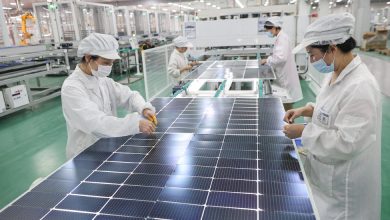Slowdowns in the U.S. and China will hold back global growth, a report says.

Slowdowns in the world’s two biggest economies — the United States and China — are likely to be larger than expected this year, dragging down output on every continent and reducing global growth, a new report warned on Tuesday.
Higher inflation, supply chain choke points, and Covid-related shutdowns and worker shortages continue to afflict rich and poor nations, the International Monetary Fund wrote in its latest World Economic Report.
“The global economy enters 2022 in a weaker position than previously expected,” the fund said in reducing its estimated global growth rate to 4.4 percent from the 4.9 percent it projected just three months ago.
The fund said the failure of the Biden administration’s sweeping $2.2 trillion infrastructure and social policy package and the Federal Reserve Bank’s tighter monetary policy were among the reasons it reduced the U.S. growth forecast by 1.2 percentage points to 4 percent.
In China, which has powered much of the world’s growth in recent years, the I.M.F. pointed to the collapse of the real estate sector and the zero-Covid policy that has restricted travel, shut businesses and reduced consumption. The report reduced the country’s growth forecast by 0.8 percentage points to 4.8 percent.
The fund emphasized that the forecast was subject to a high level of uncertainty — about the course of Covid, the prospects of climate-related natural disasters, supply chain disruptions and rising political tensions, particularly around Ukraine. With the pandemic entering its third year, a note of pessimism underlay the report. “Risks overall are to the downside,” Gita Gopinath, the first managing deputy director, said.
Global economic losses related to the pandemic will total $13.8 trillion by the end of 2024, Ms. Gopinath estimated.
Understand Inflation in the U.S.
- Inflation 101: What is inflation, why is it up and whom does it hurt? Our guide explains it all.
- Your Questions, Answered: We asked readers to send questions about inflation. Top experts and economists weighed in.
- What’s to Blame: Did the stimulus cause prices to rise? Or did pandemic lockdowns and shortages lead to inflation? A debate is heating up in Washington.
- Supply Chain’s Role: A key factor in rising inflation is the continuing turmoil in the global supply chain. Here’s how the crisis unfolded.
The dimmed economic prospects come at a time when governments have less room to maneuver in how they spend their money. Debt levels have soared over the past two years as countries struggled with the health crisis caused by the pandemic and funneled aid to their citizens. Public spending is unlikely to reach the same levels in the future.
The troubling rise in inflation that has doubled heating costs in much of Europe and made food less affordable in places like sub-Saharan Africa and Brazil has also lasted longer than anticipated.
The pandemic has changed the way people in many parts of the world spend their money, shifting funds that might have been used for dining, travel and entertainment to goods they can play with, sit on or consume at home. That increased demand, combined with persistent difficulties in moving goods from one city or continent to another, skyrocketing energy prices and labor shortages have driven up costs.
Some of those pressures are expected to wane toward the end of the year — but not everywhere. “In the United States the story is different,” the fund noted. The exit of so many people from their jobs has created more persistent labor shortages and driven up wages much more than in other countries. Americans’ high level of spending has also created some of the worst supply chain disruptions.
The U.S. Federal Reserve has made clear that its primary focus has shifted from stimulating the economy during the pandemic to fighting inflation. The bank, which is set to release its next policy statement on Wednesday, is raising interest rates and reeling in its purchases of bonds that ensured money would continue to flow through the economy. Other central banks, including those in Mexico and Brazil, are taking similar actions.
The strategy is to discourage people from borrowing money to buy a car or invest in a business and ratchet back demand for products that are in short supply. Creeping interest rates, though, not only risk slowing economic growth, but burdening poorer nations with even bigger debts far into the future.
“If interest rates rise more sharply, that then puts extra strain on vulnerable developing countries which have most of their debt in dollars,” said Creon Butler, research director at Chatham House, a London research organization. That means governments must use scarce resources to repay bulging loans instead of adding hospital beds or feeding hungry children.
Inflation F.A.Q.
What is inflation? Inflation is a loss of purchasing power over time, meaning your dollar will not go as far tomorrow as it did today. It is typically expressed as the annual change in prices for everyday goods and services such as food, furniture, apparel, transportation and toys.
What causes inflation? It can be the result of rising consumer demand. But inflation can also rise and fall based on developments that have little to do with economic conditions, such as limited oil production and supply chain problems.
Where is inflation headed? Officials say they do not yet see evidence that rapid inflation is turning into a permanent feature of the economic landscape, even as prices rise very quickly. There are plenty of reasons to believe that the inflationary burst will fade, but some concerning signs suggest it may last.
Is inflation bad? It depends on the circumstances. Fast price increases spell trouble, but moderate price gains can lead to higher wages and job growth.
How does inflation affect the poor? Inflation can be especially hard to shoulder for poor households because they spend a bigger chunk of their budgets on necessities like food, housing and gas.
Can inflation affect the stock market? Rapid inflation typically spells trouble for stocks. Financial assets in general have historically fared badly during inflation booms, while tangible assets like houses have held their value better.
The slowdown in China, which is both a major supplier and buyer of goods traded with other countries, is also setting off reverberations around the world. The once exuberant real estate market has plunged. The government has imposed the world’s most stringent restrictions and lockdowns to contain Covid, and unexpected power outages have further hindered industrial production.
Growth in the euro area was revised down by 0.4 percentage points to 3.9 percent, but for some countries, the drop was much steeper. Clogs in the supply chain, especially those affecting the auto industry, prompted the I.M.F. to estimate that growth in Germany — the largest economy in Europe — would decline by 0.8 percentage points, twice as much as the average of all countries that use the euro.
Covid continues to maintain its grip and the threat of a new variant remains, but the fund expects severe illnesses, hospitalizations and deaths to drop to low levels by the end of the year.
Claus Vistesen, chief eurozone economist at Pantheon Macroeconomics, said that the impact of this latest surge had not been as devastating: “We’re seeing evidence that Omicron is holding back economic activity, but nowhere near to the same extent as the virus did before.”
Although the fund raised its growth expectations for 2023, it emphasized that the small improvement would be insufficient to counteract the slowdown in 2022.
Ms. Gopinath of the I.M.F. emphasized that however difficult the recovery has been in wealthier nations, emerging economies have been hit the hardest, with weak growth and low vaccination rates.
With 70 million more people living in extreme poverty than before the pandemic, the fund called for more international cooperation to work out debt relief for struggling nations as well as more equitable distribution of Covid vaccines, tests and treatments.




